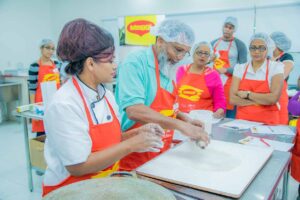Humidity and heat are all relative in South Florida. Compared to February, a night in June is hotter than a pot of simmering conch chowder, but as opposed to August, it is like swimming in a bowl of gazpacho. There is that magical time of day, right before dusk, when the sun has dropped just enough that it doesn’t feel as if it were trying to burn the skin right off your body and the mosquitoes that infest this once-swampland have not begun to bury a tunnel through you to get at your bone marrow. It was this time of day my friends Deborah and Kerry led Patrick and me through the historic district of Sailboat Bend in Fort Lauderdale in search of mangoes, glad for the slower traffic and shade as we left Cooley’s Landing Marina on our bicycles through the tree-canopied streets.
“The best-tasting mangoes are the ones you steal.” Kerry’s voice was low and conspiratorial as he spoke over his shoulder from the bicycle ahead of mine. The words floated on the still air back to his wife who trailed behind me, looking up at the overhanging tree canopy for signs of the golden fruits hanging heavy.
“We aren’t stealing,” she corrected with a laugh. “We are foraging.” Her eyes never looked down to the road ahead; they stayed glued to the treetops. I glanced up. Royal poinciana trees exploded in fiery orange blossoms through their feathery leaves right next to the splatters of lilac of the jacaranda trees. I couldn’t see a single mango. Unlike Deborah, this was my first mango hunt, and I had not yet trained my eye to spot the clusters. She had grown up in Fort Lauderdale and ridden these streets every year in search of the sweet treats. Her mental memory map knew where the best-tasting ones grew and could navigate the winding narrow streets without paying attention to where she were going, but I had to keep reverting my attention to the road ahead as not to plow into the back of Kerry. My next glance skyward revealed an overhang of thick elongated emerald leaves. Dotted throughout, oblong yellow fruit weighed the branches.
“There’s some!” I pointed upward excited to spot my first fruit and swiveled on my seat, proud, to show Deborah. “That tree isn’t worth it.” She shook her head with the authority of a seasoned mango hunter. When it comes to the best-tasting mangoes in South Florida in the month of June you can afford to be picky and pass by the obvious ones. A mango tree, when in fruit, can produce up to 200 mangoes at a time, making it almost impossible for one person to consume them all. It was as if we were doing the neighborhood a favor by taking some of its abundance … at least, that’s what I was telling myself.
“There is more meat on the Haden variety. That’s the one we like.” Over the years I’d learned more about life in Florida from Deborah than any book I’d read, and this year, I was learning about mangoes. “They are juicier and have more flesh.”
Ahead, Kerry checked both left and right before entering an overgrown alley. He glanced back over his shoulder checking if we were being followed like an informant worried who was listening.
“Here it is.” He whispered once we got to his favorite secret spot. “The one in this alleyway are the best-tasting public ones in the neighborhood.” We may be on a scavenger hunt but none of us wanted to be arrested for breaking into yards to steal fruit.
Scattered on the path and hidden in the overgrown grasses dozens of mangoes, all with a crimson blush, lay in wait for us. “You have to get to them before the raccoons and insects.” Kerry used the toe of his running shoe to roll one over for inspection revealing the half-eaten underside swarming with ants. Thick yellowy juice oozed from the gaping hole in the skin revealing perfect ripeness and lost tastiness to the creatures whom had gotten there first.
As if on cue, above us the branches shook as a large fury mass ran along a limb. Half a dozen red and golden mangoes rained from the tree and dropped at our feet in response to the jostling and weight of what I hoped was a raccoon and not one of south Florida’s other rodents. Deborah parked her bike against the fence and pulled a plastic bag from the basket on front. “Perfect timing.” She gathered the large untouched tropical treasures and handed them to me. “I already have too many piled on my table at home.”
My mind raced with ideas on what to do with our bounty. I felt like I were misquoting Forrest Gump while rattling off all the mango recipes I knew. “Mango salsa with black beans and avocado, mango chutney for grilled chicken, mango-coconut upside down cake, mangoes poached in sweet red wine over vanilla ice cream, mango bread —”
Deborah laughed again. “I usually just stand over the sink eating them.” With our loot stashed in the bags, we snuck out of the alley as stealthily as we entered. As we rode back through the neighborhood toward the marina with our smuggled goods, I checked my watch in the burgeoning moonlight and couldn’t help but think of the time involved in preparing each of the recipes. Deborah was right. Mangoes need not be baked or messed with to taste better. I smiled, knowing that within minutes, I, too, would have juice running down my elbows as I sucked the pits over the sink. After all, my first rule in cooking has always been to follow the advice of a local.





